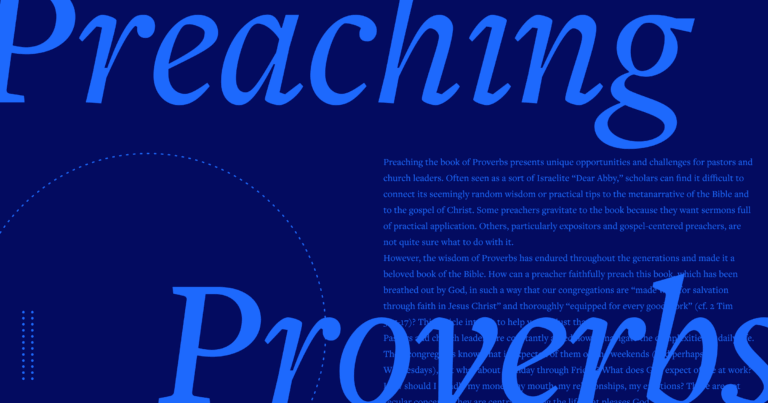
Many of us are familiar with some idea of “Sunday school” activities as a unique form of Christian education, distinct from the teaching and formation that occurs during worship, the sermon, or more intimate settings like small group Bible studies. There’s a kind of universal Christian value placed on teaching to equip disciples of Jesus to grow in their understanding of the “faith delivered once and for all to the saints” (Jude 1:3 LEB) and in their maturity in Christ (cf. Eph 4:13; Col 1:10; Jas 1:4).
Into this mix of teaching and discipleship, we find a group of related words:
- Catechesis (the process)
- Catechumen (one undergoing the process)
- Catechism (the specific form of catechesis being used)
But is catechesis simply a variation of Sunday school programming? Where does it fit within the matrix of Bible study, Christian education, and discipleship?
Table of contents
What is catechesis? 3 essential traits
To answer this, it’s most helpful to define catechism under three headings: fundamental, formal, and organic.
1. Catechesis is fundamental
Catechesis is a method of teaching Christian doctrine that provides the fundamentals or basics of the faith to those who are new or incredibly “young” to it. This process can look different depending on the context, but it includes new adult believers as well as young children or teens who, while they may have been baptized earlier, need formation in the rudimentary aspects of the gospel.
Historically, churches used catechesis with people entering the faith which would culminate in their baptism (usually on Easter). Catechesis is also appropriate for those who have joined a new branch or expression of Christianity (e.g., a Baptist who joins an Anglican church, a Presbyterian who becomes Lutheran, etc.).
2. Catechesis is formal
It’s important to note that every catechesis program will follow a particular catechism. A church that has a catechesis program will use a specific catechism that follows the particular form of its denominational context. For instance,
- Anglicans have a few varieties of catechism (e.g., Book of Common Prayer 1928)
- Many Presbyterians use the Westminster Catechism
- Lutherans follow one of Luther’s two catechisms
- The Roman Catholic Church has the Catechism of the Catholic Church
Each of these follows a sequential and formalized pattern of teaching. Martin Luther helped popularize a question-answer format which most contemporary catechisms follow.
3. Catechesis is organic
This idea may seem to contradict the formality of catechesis, but it doesn’t. The formal structure of a catechism allows for an organic flow to the actual conduct of the catechism classes.
A bad catechism class is one where the catechist, or teacher, simply runs through the catechism and dismisses students for private memorization. The purpose of the catechetical process is to use a clear, formal program to solidify a person’s grasp of the fundamentals of the faith. This means the classes ought to serve as places of dialogue, exploration, application, and investigation.
A good catechism, and a good catechist, produces deep reflection with questions like, “What does the catechism mean by this phrase?”; “How do we know that Jesus is [insert description from catechism]?”; “How does this [part of the catechism] apply to my life?” These are the kinds of organic questions that catechesis should generate.

Catechesis in the Bible: 5 examples
While catechesis has grown and developed throughout the church’s history, it begins in Scripture.
The word from which we get the term catechesis (and its related terms) is κατηχέω (katecheo) and means a handing-down of a specific teaching to be memorized or, more literally, “echoed-back.”
 A Bible Word Study on κατηχέω in Logos.
A Bible Word Study on κατηχέω in Logos.It may be helpful to frame our understanding and application of “catechism” around the Bible’s use of this word.1
1. The gospel as narratival catechesis
Luke’s Gospel aims to give an account of the faith in which his audience has already been catechized (Luke 1:4, κατηχήθης). In other words, Luke sought to supplement his readers’ knowledge with a narrative of Jesus’s life so they might know with certainty those things they had learned in their program of catechesis.
2. The example of Apollos, Priscilla & Aquila
The book of Acts introduces Apollos of Alexandria as one who had been a catechumen (Acts 18:25, κατηχημένος) in the way of the Lord under the teaching of John the Baptist.
Priscilla and Aquila, recognizing his successful catechesis (his grasp of the fundamentals), brought him into a more rigorous discipleship program to equip him for the work the Lord had called him to do (cf. Acts 18:26–28).
3. The power of malformed catechesis
In a twist on proper catechesis, those who had been falsely catechized (κατηχέω) by the leaders of the Jews tried to destroy Paul in Acts 21. Upon arriving in the Holy City, the apostles advised Paul to go to the temple with men who were completing a Nazirite vow so that the catechumens of the scribes and Pharisees would put away their violence (vv. 21–25). Things didn’t go as planned, however, and Paul was attacked.
This example of catechesis alerts us to its powerful impact: It doesn’t merely inform the mind. It also conforms behavior. Far from merely a recitation of concepts, catechesis shapes desires and directs actions.
 Logos’s search results for κατηχέω across the New Testament.
Logos’s search results for κατηχέω across the New Testament.4. Catechesis without faith is dead
Paul uses the image of catechesis in his argument in Romans 2. He challenges those who put confidence in their having been catechized (v. 18, κατηχούμενος) under the Law: Are they, in all of their teaching and instruction (catechesis), actually able to live according to the Law of God?
Paul’s use of this imagery teaches us that catechesis without faith is useless. Catechesis serves a growing faith in Jesus Christ that produces good works and a life in the Spirit (cf. Rom 3:22–24; 2 Pet 3:18; Jas 2:14–26).
5. Relationships of mutual sharing
Over and against this, Paul exhorts the Galatian church to a life-giving atmosphere of formation where everyone carries one another’s burdens (Gal 6:2).
In such a community, the relationship between the catechist (κατηχοῦντι) and the catechumen (κατηχούμενος) should be one of mutual sharing, without rivalry or tyranny. The student shares with his teacher, just as the teacher shares what he knows with his students (v. 6). Catechesis according to the Bible, then, is more than an impersonal course of study. It’s not a mere box to be checked on one’s spiritual journey. It entails a relationship of mutual encouragement and learning as “we all, with unveiled face, reflecting the glory of the Lord, are being transformed into the same image from glory into glory” (2 Cor 3:18 LEB).

5 keys to fruitful catechesis
So a fruitful catechesis program goes beyond a simple transfer of knowledge. Instead, it provides a holistic approach to spiritual formation.
But practically, how do we do this? Allow me to offer five keys.
1. Fruitful catechesis begins with a delight in God’s Word
There’s a seldom spoken fear that, when it comes to Christian education, the very act of formalizing doctrine will dull it. Some of us have had experiences that seem to justify these concerns: the boring Sunday school class, the lame small group, the lifeless Bible study. But this is a misdiagnosis.
The problem is not the sheer formalization of doctrine or of the course of study; rather, it’s almost always a dispassionate approach to God’s Word by either the teacher or the students. What makes catechesis exciting and fruitful is a delight in God’s Word—an eager, ravenous, inquisitive spirit, longing to know God as he is revealed in Scripture.
But how do we foster this sort of delight in God’s Word? It’s far more contagious than it is teachable. Catechisms are born from Scripture and should lead us back to it with a sense of hunger and devotion. Catechists themselves must cultivate an eager delight in God’s Word and teach from that passion. “Knowing the answers” is one thing; “loving them” is another entirely.
What makes catechesis exciting and fruitful is a delight in God’s Word—an eager, ravenous, inquisitive spirit, longing to know God as he is revealed in Scripture.
2. Fruitful catechesis unites information with discipleship
As we’ve seen, catechesis is about far more than depositing information. A catechism worthy to bear the description “Christian” is concerned with forming followers of Jesus.
This does not mean that we must degrade or dispense with the formal teaching of a catechism or that it is secondary to conduct. No. But it means that we cannot stop at the mere transmission of content. Good catechesis unifies information with discipleship so that what is taught in the catechism is applied and lived out in the life of the catechumen. We don’t want to be merely hearers of catechesis, but doers of it.
All theology is practical theology. For example, we should unite the catechetical teaching about the justice of God with how we live with our own neighbors, and we should connect the incarnation of Christ with our own lives as members of his Body.
3. Fruitful catechesis isn’t about “covering” content
Teachers often talk about “covering the content,” which means getting through all the prepared teaching material in a given unit. But this language betrays us. Lendol Calder, in his incisive essay on the history of pedagogy, notes that “to cover” has another meaning: to conceal.2
Often when teachers—whether history teachers, catechists, or others—aim simply to “cover” content, the result is that material is not uncovered, explored, and engaged with, but crammed and quickly forgotten.
Calder’s pedagogical insights should inform how we conduct catechesis classes. We want to expose, unveil, and illumine the fundamentals of the faith in ways that draws the catechumen deeper into the mystery, not in ways that results in such things being forgotten immediately after the course is concluded. We do not, in other words, want to cultivate a kind of learning climate in our churches which produces those who hear the Word but do not do it, who look at themselves and go away and immediately forget what they saw (cf. Jas 1:23–24).
4. Fruitful catechesis unites memory & curiosity
While we want to avoid simply “covering” content, we shouldn’t shy away from the kinds of deep learning that comes with emphasizing memorization.
We live in a world dominated by a pervading sense of perpetual access. I can look up anything I want on a smartphone and have an answer within seconds. But this kind of “at-your-fingertips” knowledge is ephemeral. Rarely does it remain with you.
While this kind of knowledge is useful for certain things (e.g., finding a nearby restaurant), it is not good for the vital truths that catechesis aims to teach. The fundamentals of the faith should be deeply internalized. We should think of them, not like files in the storage of the soul, but far more like our operating system. Memory has the unique capacity to anchor what we learn in the realms of imagination, reflection, and habit. Catechesis is the kind of instruction I want running constantly below the surface of my awareness.
A good catechism class combines the passionate curiosity that comes from a love of Scripture with a strong focus on memorization. They are “perichoretic” features: each magnifies and intensifies the other.
5. The goal of fruitful catechesis is doxology
Finally, keep in mind that the ultimate goal of catechesis is doxology: a life of worship, prayer, and thanksgiving to the living God. Every catechism’s long-term aim is to form worshipers. Catechist must remember that “from him and through him and to him are all things” and we must teach so that he receives the glory (Rom 11:36 LEB).
Therefore, the cultivation of the love of God must remain a central focus in any catechesis program, lest we produce folks whose propositional theology is correct but who are in the final estimation “ringing brass gongs or a clashing cymbals” (1 Cor 13:1 LEB). For instance, at the end of each segment of the catechism, the catechist could ask how the instruction leads the catechumens to more fully inhabit the kingdom of Jesus (cf. Col 1:13). A good catechesis class is one that keeps the first and second commandments in first and second place (cf. Matt 22:34–40).
Mark Brians recommended resources on catechesis
In the Name of Our Lord: Four Models of the Relationship Between Baptism, Catechesis, and Communion
Save $1.35 (5%)
Price: $25.64
-->Regular price: $26.99
Making Disciples: Catechesis in History, Theology, and Practice
Save $10.00 (33%)
Price: $19.99
-->Regular price: $19.99
Ancient-Future Evangelism: Making Your Church a Faith-forming Community
Save $1.00 (5%)
Price: $18.99
-->Regular price: $19.99
The Early Church at Work and Worship, Volume 2: Catechesis, Baptism, Eschatology, and Martyrdom
Save $1.30 (5%)
Price: $24.69
-->Regular price: $25.99
Catechisms from different theological traditions
Catechism of the Catholic Church, Revised
Save $3.00 (12%)
Price: $20.99
-->Regular price: $20.99
The Great Catechism of the Holy Catholic, Apostolic, and Orthodox Church
Save $0.27 (5%)
Price: $5.22
-->Regular price: $5.49
Luther’s Small and Large Catechism with Select Commentary (6 vols.)
Save $1.65 (5%)
Price: $31.34
-->Regular price: $32.99
To Be a Christian: An Anglican Catechism
Save $0.90 (5%)
Price: $17.09
-->Regular price: $17.99
Westminster Confession of Faith | WCF (including the Larger and Shorter Catechisms, American Revision, 3 vols.)
Save $0.90 (5%)
Price: $17.09
-->Regular price: $17.99
The Baptist Catechism, Commonly Called Keach’s Catechism: Or, a Brief Instruction in the Principles of the Christian Religion
Save $0.12 (5%)
Price: $2.37
-->Regular price: $2.49

The New City Catechism: 52 Questions and Answers for Our Hearts and Minds (The Gospel Coalition)
Save $0.35 (5%)
Price: $6.64
-->Regular price: $6.99
Related articles
- 5 Ways to Motivate & Train Students in Evangelism
- How to Be a Great Youth Pastor: A Complete Guide
- Family Discipleship: 5 Easy Things You Can Do with Your Kids
- 5 Ways Love Is the Secret to Better Bible Teaching
- Relying Upon God in Teaching Ministry


 3 weeks ago
38
3 weeks ago
38










 English (US) ·
English (US) ·